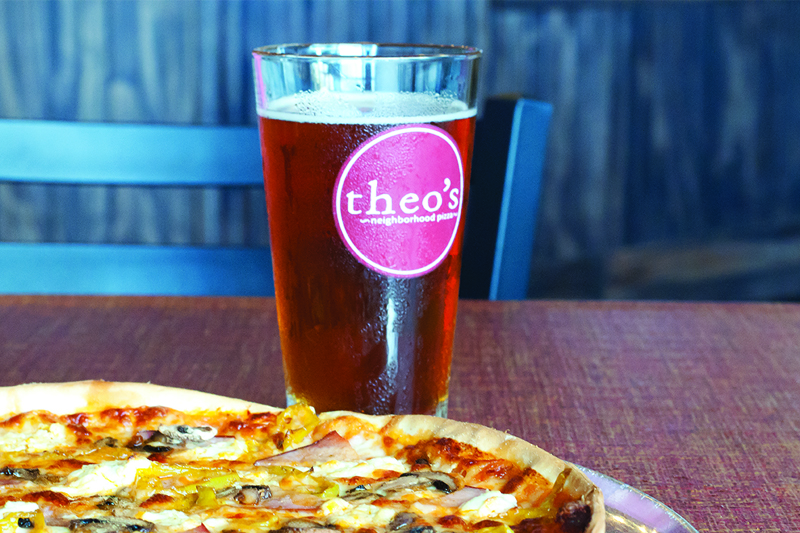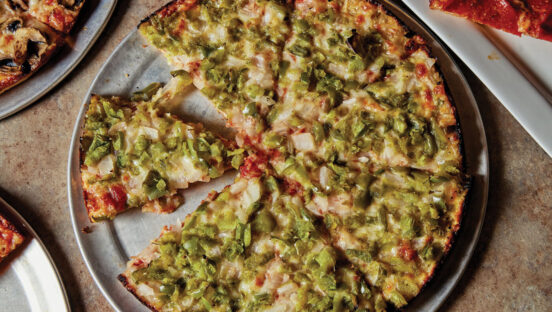For many customers visiting their favorite pizzeria, nothing complements the meal better than an ice-cold beer. The good news is, with an ever-expanding array of brews available from across the country (and world), you have a bevy of options—and these beers can pair perfectly with any style of pizza you may offer, from basic white and Margherita to meat, veggie and more exotic choices.
“With many similarities between the two food categories, craft beer and pizza are natural companions,” notes Julia Herz, publisher of CraftBeer.com and craft beer program director at the Brewers Association in Boulder, Colorado. “They both have a wide range of producers, from large corporate companies to small, independent and artisanal ones. With our association documenting 142 beer styles, there is a very broad rainbow of pairing options for a variety of pizzas.”
Harmonies of Flavor
Turns out there’s a bit of science behind the logic of pairing these two American classics. “Pizza and beer are a match made in heaven, and there’s a reason for that,” says Eric Lorberfeld, owner of Growlers Beer Bistro in Tuckahoe, New York. “The right beer will stand up to the acidic tang of the tomato and cut through the fatty cheese, creating harmony between flavors and textures. For basic pizzas, lagers and pilsners match best, mainly because the spicy hop character contrasts nicely with the cheese, and the malty finish and crisp carbonation cleanse the palate after each bite/sip.”
For meat lovers pies, Lorberfeld recommends an American pale ale or IPA with a high hop profile, such as Sierra Nevada Pale Ale, while veggie pizzas pair with brown ale, like Samuel Smith’s Nut Brown Ale. For a classic Margherita, he suggests a well-balanced, clean and lightly hopped beer, like a Reissdorf Kölsch from Germany.
“When pairing pizza and beer, one basic tip can help guide you to home runs: Work to find harmonies of flavor,” Herz advises. “Pizza’s soul is the crust. The same flavors of pizza’s toasted, bready crust carry over to similar flavors from the malt of multiple beer styles. Pilsner and wheat malt harmonize well with pizza flour. The same maillard reactions that harden and advance the flavors of dough into mellanoidin-laden crust exist in beer’s kilned malts, including pale malt, Vienna malt, Munich malt and others. This is a good thing!”
Additionally, Herz continues, beer’s hops (and the bitterness they provide) help balance the richness of cheese, while the acidity in beer helps neutralize the cheese’s saltiness so customers can better taste the pizza’s other ingredients. “Add to that the herbal notes of many hops (pine, spruce, woodsy, forest and more) and how they bridge to the many herbs used in pizza, and you’re now dancing in the divine!” says Herz.
As Jennifer Glanville, a brewer with Boston-based Samuel Adams, notes, with so many varying flavors in pizza, including sauce, cheese and dough, pizzeria operators benefit from offering a well-balanced beer to work with all possible flavor combinations. “A significant malt base pairs well with any crust, and a great hop finish matches the acidity in the tomato sauce and heaviness of the cheese and toppings,” she says. “The rich, malty flavors develop and deepen the flavors of heavier toppings like meat and cheese, while the hop character cuts through some of the richness. And flavors in the beer (like earthy, nutty and smoky) are reflected and enhanced in cheese. The yeast character of the beer also works with the similar tastes in the cheese that come from its natural maturation process.” In addition, says Glanville, beer’s carbonation and bitterness lifts the creaminess of the cheese from the palate, and a well-balanced brew creates added depth of flavor without overpowering the taste of other ingredients.
 |
|
Beer flights help customers at Slice Pizza & Brew in Birmingham, Alabama, settle on the perfect brew for their favorite pie. |
Going Local
At Piecasso Pizzeria & Lounge (piecasso.com) in Stowe, Vermont, part of the company culture involves showcasing the local beer community—and, luckily, there are numerous award-winning breweries within 30 miles that craft styles from Belgians to browns to traditional Austrian lagers. With so many high-end craft brews “right in our backyard,” says owner Eduardo Rovetto, the pizzeria often hosts “tap takeovers,” when one brewery will monopolize five to seven taps as chefs whip up marinades, batters and sauces that incorporate its beers.
“My beer program always represents variety, but many of our beers come from Vermont. Finding the right balance is key, because pairing preferences are going to vary from customer to customer,” explains George Spraker, Piecasso general manager. A sausage-and-pepper pie might call for an IPA, while a white-based pie pairs well with a nonbitter brew, such as a lager, Helles or hefeweizen. “But, in reality, it often comes down to what the customer prefers in his beer and pizza flavors,” says Spraker. “Hops are an acquired taste, while some people like porters and stouts. We try to cover all bases to suit all palates.”
To let both employees and customers know about Piecasso’s different beers (which often change), the beer list is reprinted a couple of times per day with explanations of each beer, including its price, alcohol content and flavor profile. Meanwhile, notes are entered into the POS system regularly to ensure that employees know about any changes when they log in. An active, communicative staff is key to properly recommend suitable pairings, Spraker notes. For curious customers, Piecasso updates its website’s beer list daily, and social media posts promote new arrivals.
For pies with strong flavors like barbecue, pesto or Buffalo chicken, Spraker might recommend Otter Creek Copper Ale for its aromatic qualities, notes of grapefruit and citrus, and hop finish. A meat pie with red sauce pairs well with Belgian styles, with their slightly salty finish, or geuze, with its touch of hops and smoke. The pizzeria’s chefs have also honed their palates by hosting beer dinners with food-and-brew courses; the brewer himself or a liaison from the company brings in bottles so staff members can taste them beforehand and create appropriate pairings. Between pairing possibilities and incorporating beers directly into food items, “there are a lot of things we can do with beers,” Spraker says.
Roots Handmade Pizza (rootspizza.com) in Chicago also takes a local approach with its beer menu, choosing only Midwestern brews to complement its “Quad Cities-style” crust, which incorporates brewer’s malts and thus naturally pairs well with beers. “We leave it to our servers to recommend beers based on the customer’s personal preference—for example, do they like sweeter or drier styles?” says manager Malinda Reicher. “Generally, spicy pizzas pair well with pale ales, which add tang, and meat pies are great with a rye or amber. When you pair opposite flavors, you can really pull out the flavors in each.” Hence, salty meats like bacon and prosciutto are contradicted (in a good way) by sweeter styles.
Roots’ staff members remain well-educated thanks to frequent brewery tours in the Chicagoland area, plus visits to breweries in nearby states every month or two. Meanwhile, reps from breweries often drop in to host classes with the staff, teaching about the brewery’s culture and beers (including ingredients and how they’re made), and in-house classes fill in the blanks. “There are so many styles of beer now, it’s hard to include them all, but IPAs are very popular, and we keep a well-rounded menu year-round to please everyone,” says Reicher.
Menu Mentions
Slice Pizza & Brew (slicebirmingham.com) also maintains a well-educated staff to inform customers about its many beers on offer, but the menu itself lists pairing suggestions for every pizza. Executive chef Terrill Brazelton did Internet research to learn about common pairings (such as IPAs with strong/spicy/curry flavors; pale ales with meats/fried foods/hearty flavors; porter with smoked cheeses and meats; and brown ales with sausage, fish or Gouda cheese).
Brazelton recommends similar basic research to find traditional pairings, but he also recommends trusting your taste buds and experimenting—then showing customers the way through your menu. “Offering so many beers can be overwhelming for some customers, so suggested pairings on the menu can point them in the right direction, which opens their palates and allows them to try new beers—and today’s customers love to try new things,” Brazelton observes.
To facilitate pairing, he might also incorporate beers into the pizzas themselves. Slice’s Lakeview pizza features short ribs braised in a local IPA, and the Wing & a Prayer pie is topped with chicken braised in pale ale. “When you cook with a style of beer, it eases you in; you feel and taste that connection,” Brazelton says. “To find what’s right, I recommend simply doing as much tasting as possible.”
In general, Brazelton likes lighter beers with lighter foods—think chicken or lighter sausages with wheat beers or Biere de Garde. Slice’s White Shadow, with portobello mushrooms, pairs with an earthy brew like saison. In winter, he recommends pairing red-sauce Margheritas with a pilsner, pale ale or lager, while in summer these pies are made with fresh tomato and fit better with a saison or Biere de Garde. “I don’t think there are any hard and fast rules,” laughs Brazelton. “If you like a beer, any pizza can go well with it!”
However, even with menu recommendations, Slice’s staff stays abreast of how to help customers select a beer that’s right for them. Bartenders or waitstaff will ask customers what they drink at home to get an idea of preferred styles. Brazelton recommends that staff try the beers offered, with owners or managers soliciting feedback on what they taste in the beer. “Throw caution to the wind and research the best pairing possibilities,” he suggests. “Start with the basics and go from there. There’s a lot of knowledge out there, but you’re in this business for a reason—trust your palate!”
Tracy Morin is PMQ’s senior copy editor.
| Five Takeaways |
|
When helping your guests choose the right beer for their pizza, keep these points in mind:
|















